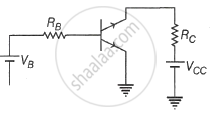Advertisements
Advertisements
प्रश्न
What is rectification?
उत्तर
- Rectification is the process of converting alternating current into the direct current is called rectification.
- An alternating current voltage varies sinusoidally, which means that its value and direction change in one cycle.
- A rectifier turns this bidirectional voltage or current to a unidirectional voltage, which is then converted to a DC voltage. This is known as correction.
- Rectification is the process of converting an alternating current voltage to a direct current voltage.
APPEARS IN
संबंधित प्रश्न
Describe the function of a transistor as an amplifier with the neat circuit diagram. Sketch the input and output wave forms.
If l1, l2, l3 are the lengths of the emitter, base and collector of a transistor, then ____________.
Least doped region in a transistor ____________.
In an npn transistor, the base current is 100 µA and the collector current is 10 mA. The emitter current is ______.
Which of the following regions of a transistors are, respectively, heavily dopped and lightly dopped?
In an npn transistor circuit, the collector current is 10 mA. If 90% of the electrons emitted reach the collector, the emitter current (IE) and base current (IB) are given by ____________.
For a common emitter configuration, if 'α' and 'β' have their usual meanings, the correct relationship between 'α' and 'β' is ______.
A transistor when connected in common emitter mode has a ____________.
In the case of transistor, the relation between current ratios αdc and βdc is ______.
A common emitter amplifier circuit built using an n-p-n transistor is shown in the figure. Its DC current gain is 300, RC = 4 kΩ and VCC = 20 V. What is the minimum base current for VCE to reach saturation?

